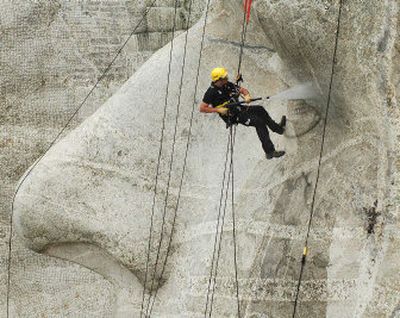Mount Rushmore gets facial thanks to German company

MOUNT RUSHMORE NATIONAL MEMORIAL, S.D. – Call it a makeover of monumental proportions.
A crew began a project Thursday to wash the granite faces of Mount Rushmore to remove decades of dirt, grime and lichens that can damage the complexion of the four presidents.
The workers began scaling the mountain and offered a demonstration of the pressure washing Thursday, and plan to start the full-scale cleaning today. The job could take five weeks.
Thorsten Mowes, a technician with the German company leading the project, started the demonstration Thursday by spraying the left side of Thomas Jefferson’s forehead with a stream of pressurized water. He also gave Jefferson’s eyelid and jaw a quick blast. “The roots of the lichens are digging into the stone,” said Mowes, who scaled George Washington’s face in April and discovered invasive lichens.
It is the first time in Mount Rushmore’s 65-year history that the famous South Dakota monument is getting such a cleaning.
The washings are compliments of a German manufacturer of cleaning machines that has donated 80 such projects around the world, said Alfred Karcher GmbH & Co. KG spokesman Frank Schad. He said the company pressure-washed the base of the Statue of Liberty two years ago and was looking for another interesting project to do in the United States.
“As a federal agency, we don’t have a lot of money in our budget to be pressure-washing faces,” said Judy Olson, Mount Rushmore’s chief of interpretation. “When they said they would do it for free, that’s when we started considering having this done.”
Sculptor Gutzon Borglum carved Mount Rushmore in 21 blocks of granite that contained many pre-existing cracks. Borglum’s maintenance plan called for filling the cracks with a mixture of white lead, linseed oil and granite dust. In 1991, the monument switched to a newer silicone sealant, and Park Service workers dangle from harnesses each year to inspect and fill the cracks.
But lichens still develop in crevices and can cause “bio-corrosion,” producing an acid that can damage the faces.
“I don’t think the average visitor will be able to tell the difference” after the power washing, said Duane Bubac, Mount Rushmore facilities manager. “It’s mainly a stabilization and preservation activity.”